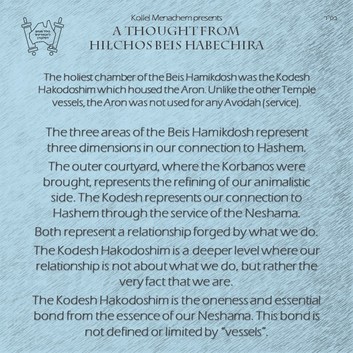
The holiest chamber of the Beis Hamikdosh was the Kodesh Hakodoshim (Holy of Holies). In the first Temple, the Aron Hakodesh stood in this room on the Even Hashesiya, the foundation stone of the world.
The Aron was hidden towards the end of the first Temple period and was not present in the second Beis Hamikdosh. Yet the Kodesh Hakodoshim remained the holiest place on earth and only the Kohen Gadol would enter it on the day of Yom Kippur.
Unlike the other vessels in the Beis Hamikdosh, the Aron was not used for any Avodah (service).
The three areas of the Beis Hamikdosh represent three different dimensions in our personal Avodah and connection to Hashem.
The outer courtyard of the Beis Hamikdosh, where the Korbanos were brought, represents our Avodah of refining and elevating our animalistic side.
The Kodesh represents our connection to Hashem through the service of the Neshama. The Menorah reflects our Torah and Tefillah. The Shulchan represents Tzedaka and engaging in the world L’shem Shamayim.
Both of these areas represent a relationship with Hashem forged by what we do; a service that requires vessels.
The Kodesh Hakodoshim expresses a level of relationship which goes beyond and deeper than what we do. At this level, our relationship is not about what we do but rather the very fact that we are. The Kodesh Hakodoshim is the oneness and essential bond from the essence of our Neshama. This bond is not defined or limited by “vessels”.
Our sages refer to the Holy of Holies as the Cheder Hamitos (lit. the Bedroom). The bedroom is a sacred space, a place of privacy that reflects the deep union and oneness of husband and wife. The Kodesh Hakodoshim, the level we access on Yom Kippur, is our deepest union and oneness with Hashem.
The Aron was hidden towards the end of the first Temple period and was not present in the second Beis Hamikdosh. Yet the Kodesh Hakodoshim remained the holiest place on earth and only the Kohen Gadol would enter it on the day of Yom Kippur.
Unlike the other vessels in the Beis Hamikdosh, the Aron was not used for any Avodah (service).
The three areas of the Beis Hamikdosh represent three different dimensions in our personal Avodah and connection to Hashem.
The outer courtyard of the Beis Hamikdosh, where the Korbanos were brought, represents our Avodah of refining and elevating our animalistic side.
The Kodesh represents our connection to Hashem through the service of the Neshama. The Menorah reflects our Torah and Tefillah. The Shulchan represents Tzedaka and engaging in the world L’shem Shamayim.
Both of these areas represent a relationship with Hashem forged by what we do; a service that requires vessels.
The Kodesh Hakodoshim expresses a level of relationship which goes beyond and deeper than what we do. At this level, our relationship is not about what we do but rather the very fact that we are. The Kodesh Hakodoshim is the oneness and essential bond from the essence of our Neshama. This bond is not defined or limited by “vessels”.
Our sages refer to the Holy of Holies as the Cheder Hamitos (lit. the Bedroom). The bedroom is a sacred space, a place of privacy that reflects the deep union and oneness of husband and wife. The Kodesh Hakodoshim, the level we access on Yom Kippur, is our deepest union and oneness with Hashem.

 RSS Feed
RSS Feed
